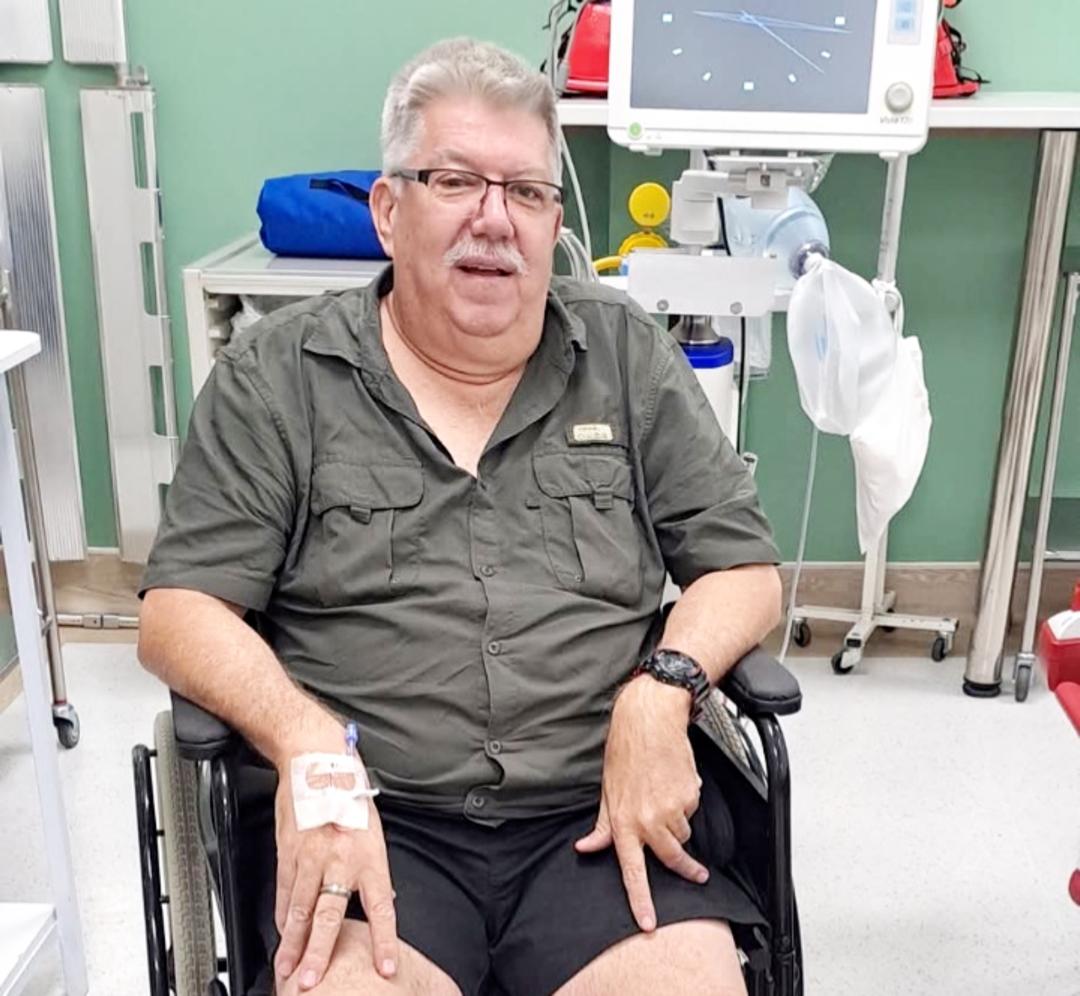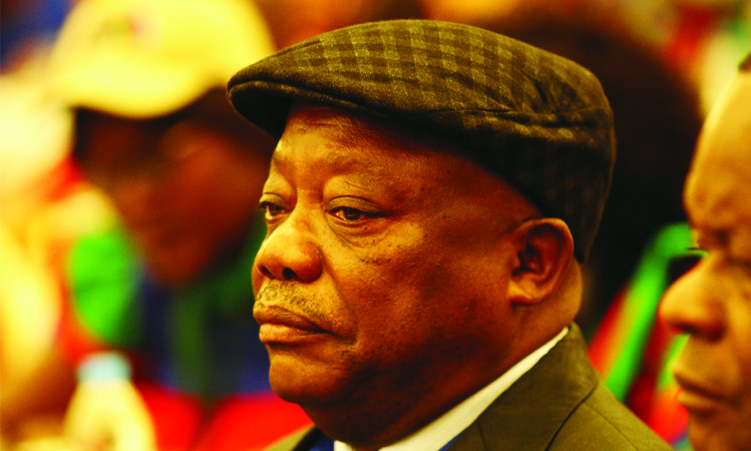THE last punches in former world champion boxer Harry Simon’s appeal against a culpable homicide conviction and two-year prison sentence were thrown in the High Court in Windhoek yesterday.
It will now be up to Judge Collins Parker and Acting Judge John Manyarara to tally the points scored by Simon’s lawyer, Sisa Namandje, and State advocate Eileen Rakow in verbal blows traded over a day and a half. Judge Parker and Acting Judge Manyarara reserved their judgement after Namandje and Rakow yesterday morning wrapped up their arguments on Simon’s appeal against being found guilty on a charge of culpable homicide, his appeal against his sentence of an effective two years’ imprisonment, and an appeal from the State for that sentence to be increased.Simon was found guilty and sentenced in the Walvis Bay Regional Court on August 4 2005.He had stood trial in connection with a horror car crash in which three Belgian tourists were killed on the road between Walvis Bay and Swakopmund on the evening of November 21 2002.The three victims died in a head-on collision between the rented bakkie that they were travelling in and a Mercedes-Benz ML500, which belonged to and was driven by Simon at the time.The collision took place at the turn-off to the Langstrand residential area between the two coastal towns.At Simon’s trial, Regional Court Magistrate Gert Retief heard testimony that the Belgians’ bakkie was seen standing stationary, on the correct side of the road, with its indicator lights on to show that it was going to turn right towards Langstrand, moments before the crash took place.According to Simon’s plea at the start of the trial, the crash was caused not by him but by the Belgians’ vehicle suddenly turning in front of his vehicle.In his plea explanation, he stated that the bakkie “drove unexpectedly and suddenly into the lane wherein I drove, occasioning the collision”.The Magistrate however convicted Simon of culpable homicide.Relying on testimony from two motor vehicle collision reconstruction experts, he found that the collision had taken place not on the side of the road on which Simon was driving on the way from Walvis Bay to Swakopmund, but on the side of the road where the Belgians were waiting to turn off to Langstrand, and that Simon was driving at a speed of at least 160 kilometres per hour.The inevitable conclusion to be made from this finding was that when the fatal crash took place, Simon’s vehicle was speeding on the wrong side of the road – and that on a stretch of road where an 80 km/h speed limit was in force and where a double barrier line indicated that it was a no-overtaking zone.Namandje launched an attack against the basis of the experts’ evidence during the hearing of the appeal this week.He argued that not only the evidence given by the two experts who testified for the prosecution, but also evidence given by another expert who testified in Simon’s defence, had to be thrown out because it was all in essence inadmissible hearsay evidence.This is so, Namandje argued, because people who had pointed out features of the crash scene on which the experts based their calculations to establish at which point the crash had taken place, were never called to testify in the trial and to confirm that they had pointed out such places at the scene to the experts.Testimony given by the only eyewitness who claimed to have seen Simon’s vehicle overtaking another car moments before the crash also had to be disregarded, because evidence from a single witness like this was supposed to have been approached with extreme caution, Namandje also argued.Rakow however argued that at least one of the experts had based her calculations – these led to her conclusion that the collision took place on the side of the road where the Belgians’ vehicle was supposed to be standing, waiting to turn off to Langstrand – on observations that she personally made at the scene.This observation was of an oil mark that the witness said she could still see on the road where the Belgians’ bakkie had come to a standstill after the crash.She visited the scene more than a year after the crash, though, and this was on a very busy stretch of road, Judge Parker pointed out repeatedly during the hearing of the appeal.Rakow however stuck to her guns, telling the court that the witness specifically excluded the possibility that the oil stain could have been from another vehicle.Namandje counter-punched against this argument as well, telling the court that the expert still did not have any personal knowledge that this oil stain on the road had come from the tourists’ vehicle.In her argument on the sentence, Rakow said Simon’s actions were no different from those of someone who walked into a room and threw a knife, not caring whether it hit someone or not.On the sentence at least, she remarked, she and the defence agreed that the Magistrate had been wrong.However, whereas Namandje argued that Simon should have been sentenced to a fine at the most if he had to be found guilty, Rakow argued that he should in fact have received a far heavier sentence.The norm in other cases of culpable homicide that do not flow from a road accident is around six years’ imprisonment, she said.There was nothing on the record of the case to indicate that Simon had any remorse, she commented.Simon remains free on bail while the court’s appeal judgement remains pending.Judge Parker and Acting Judge Manyarara reserved their judgement after Namandje and Rakow yesterday morning wrapped up their arguments on Simon’s appeal against being found guilty on a charge of culpable homicide, his appeal against his sentence of an effective two years’ imprisonment, and an appeal from the State for that sentence to be increased.Simon was found guilty and sentenced in the Walvis Bay Regional Court on August 4 2005.He had stood trial in connection with a horror car crash in which three Belgian tourists were killed on the road between Walvis Bay and Swakopmund on the evening of November 21 2002.The three victims died in a head-on collision between the rented bakkie that they were travelling in and a Mercedes-Benz ML500, which belonged to and was driven by Simon at the time.The collision took place at the turn-off to the Langstrand residential area between the two coastal towns.At Simon’s trial, Regional Court Magistrate Gert Retief heard testimony that the Belgians’ bakkie was seen standing stationary, on the correct side of the road, with its indicator lights on to show that it was going to turn right towards Langstrand, moments before the crash took place.According to Simon’s plea at the start of the trial, the crash was caused not by him but by the Belgians’ vehicle suddenly turning in front of his vehicle.In his plea explanation, he stated that the bakkie “drove unexpectedly and suddenly into the lane wherein I drove, occasioning the collision”.The Magistrate however convicted Simon of culpable homicide.Relying on testimony from two motor vehicle collision reconstruction experts, he found that the collision had taken place not on the side of the road on which Simon was driving on the way from Walvis Bay to Swakopmund, but on the side of the road where the Belgians were waiting to turn off to Langstrand, and that Simon was driving at a speed of at least 160 kilometres per hour.The inevitable conclusion to be made from this finding was that when the fatal crash took place, Simon’s vehicle was speeding on the wrong side of the road – and that on a stretch of road where an 80 km/h speed limit was in force and where a double barrier line indicated that it was a no-overtaking zone.Namandje launched an attack against the basis of the experts’ evidence during the hearing of the appeal this week.He argued that not only the evidence given by the two experts who testified for the prosecution, but also evidence given by another expert who testified in Simon’s defence, had to be thrown out because it was all in essence inadmissible hearsay evidence.This is so, Namandje argued, because people who had pointed out features of the crash scene on which the experts based their calculations to establish at which point the crash had taken place, were never called to testify in the trial and to confirm that they had pointed out such places at the scene to the experts.Testimony given by the only eyewitness who claimed to have seen Simon’s vehicle overtaking another car moments before the crash also had to be disregarded, because evidence from a single witness like this was supposed to have been approached with extreme caution, Namandje also argued.Rakow however argued that at least one of the experts had based her calculations – these led to her conclusion that the collision took place on the side of the road where the Belgians’ vehicle was supposed to be standing, waiting to turn off to Langstrand – on observations that she personally made at the scene.This observation was of an oil mark that the witness said she could still see on the road where the Belgians’ bakkie had come to a standstill after the crash.She visited the scene more than a year after the crash, though, and this was on a very busy stretch of road, Judge Parker pointed out repeatedly during the hearing of the appeal.Rakow however stuck to her guns, telling the court that the witness specifically excluded the possibility that the oil stain could have been from another vehicle.Namandje counter-punched against this argument as well, telling the court that the expert still did not have any personal knowledge that this oil stain on the road had come from the tourists’ vehicle.In her argument on the sentence, Rakow said Simon’s actions were no different from those of someone who walked into a room and threw a knife, not caring whether it hit someone or not.On the sentence at least, she remarked, she and the defence agreed that the Magistrate had been wrong.However, whereas Namandje argued that Simon should have been sentenced to a fine at the most if he had to be found guilty, Rakow argued that he should in fact have received a far heavier sentence.The norm in other cases of culpable homicide that do not flow from a road accident is around six years’ imprisonment, she said.There was nothing on the record of the case to indicate that Simon had any remorse, she commented.Simon remains free on bail while the court’s appeal judgement remains pending.
Stay informed with The Namibian – your source for credible journalism. Get in-depth reporting and opinions for
only N$85 a month. Invest in journalism, invest in democracy –
Subscribe Now!









